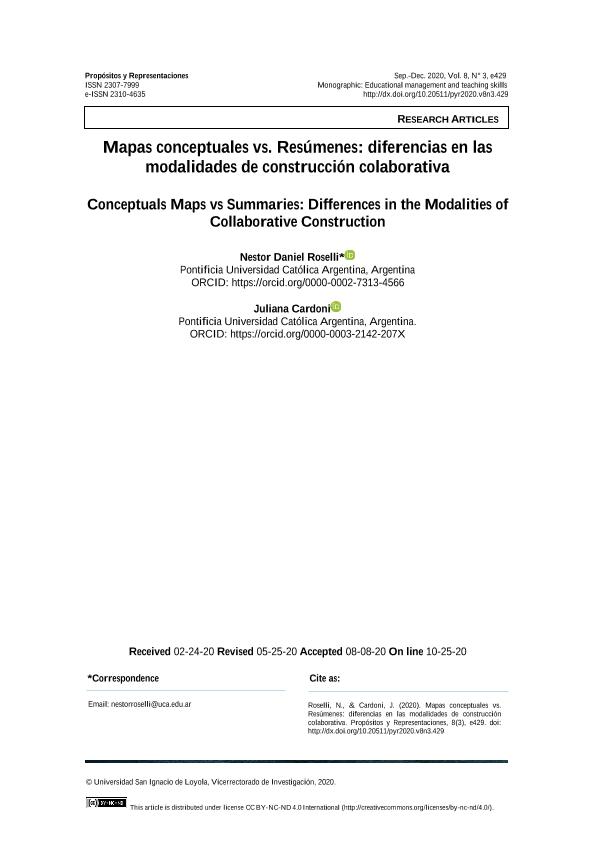Mostrar el registro sencillo del ítem
dc.contributor.author
Roselli, Nestor Daniel

dc.contributor.author
Cardoni, Juliana

dc.date.available
2022-10-04T19:39:29Z
dc.date.issued
2020-12
dc.identifier.citation
Roselli, Nestor Daniel; Cardoni, Juliana; Mapas conceptuales vs. resúmenes: diferencias en las modalidades de construcción colaborativa; Universidad San Ignacio de Loyola; Propósitos y Representaciones; 8; 3; 12-2020; 429-455
dc.identifier.issn
2307-7999
dc.identifier.uri
http://hdl.handle.net/11336/171816
dc.description.abstract
Se comparan dos recursos didácticos: el mapa conceptual y el resumen, entendidos como sistemas externos de representación cognitiva. En el enfoque teórico utilizado, tales sistemas externos no son entendidos como mera externalización del pensamiento, sino, inversamente, como tipos de actividad representacional que formatean a la propia cognición. En este sentido, los mapas y los resúmenes tendrían efectos cognitivos distintos. Pero esta investigación va más allá: tales efectos diferenciales serían también psicosociales, formateando la interacción sociocognitiva cuando la actividad se realiza colaborativamente. El diseño experimental compara cuatro condiciones de dos submuestras idénticas, en las que se balancea tanto la tarea que 18 díadas de alumnos universitarios deben realizar (mapa y resumen), como los dos textos-fuente empleados. El análisis compara las producciones individuales con la colectiva de cada díada, centrándose en las modalidades de la construcción colectiva a partir de las producciones individuales. Así, se distinguen tres modalidades básicas: homogénea, heterogénea simétrica y heterogénea asimétrica. El análisis diferencia entre aspectos cognitivos o de contenido, y aspectos específicamente formales. De manera descriptiva, los datos muestran una tendencia en el sentido de la hipótesis planteada, mostrando que ambos sistemas externos moldean de manera distinta la interacción sociocognitiva.
dc.description.abstract
Two teaching resources are compared: the conceptual map and the summary, understood as external systems of cognitive representation. In the theoretical approach used, such external systems are not understood as mere outsourcing of thought, but, conversely, as types of representational activity that format the cognition itself. In this sense, maps and summaries would have different cognitive effects. But this research goes further: such differential effects would also be psychosocial, formating sociocognitive interaction when the activity is carried out in a collaborative way. The experimental design compares four conditions from two identical subsamples, in which both the task that 18 dyads of university students must perform (map and summary) and the two source-texts used are balanced. The analysis compares the individual productions with the collective of each dyad, focusing on the modalities of collective construction based on the individual productions. Thus, three basic modalities are distinguished: homogeneous, symmetrical heterogeneous and asymmetrical heterogeneous. The analysis differentiates between cognitive or content aspects, and specifically formal aspects. Descriptively, data shows a tendency in the sense of the hypothesis raised, showing that both external systems shape differently the sociocognitive interaction.
dc.format
application/pdf
dc.language.iso
spa
dc.publisher
Universidad San Ignacio de Loyola
dc.rights
info:eu-repo/semantics/openAccess
dc.rights.uri
https://creativecommons.org/licenses/by-nc-nd/2.5/ar/
dc.subject
PSICOLOGÍA DE LA EDUCACIÓN
dc.subject
MAPAS CONCEPTUALES
dc.subject
RESÚMENES
dc.subject
INTERACCIÓN SOCIOCOGNITIVA
dc.subject
SISTEMAS EXTERNOS DE REPRESENTACIÓN
dc.subject
MODALIDADES DE COLABORACIÓN
dc.subject.classification
Otras Psicología

dc.subject.classification
Psicología

dc.subject.classification
CIENCIAS SOCIALES

dc.title
Mapas conceptuales vs. resúmenes: diferencias en las modalidades de construcción colaborativa
dc.title
Conceptuals maps vs summaries: differences in the modalities of collaborative construction
dc.type
info:eu-repo/semantics/article
dc.type
info:ar-repo/semantics/artículo
dc.type
info:eu-repo/semantics/publishedVersion
dc.date.updated
2022-10-03T18:01:04Z
dc.identifier.eissn
2310-4635
dc.journal.volume
8
dc.journal.number
3
dc.journal.pagination
429-455
dc.journal.pais
Perú

dc.journal.ciudad
Lima
dc.description.fil
Fil: Roselli, Nestor Daniel. Consejo Nacional de Investigaciones Científicas y Técnicas; Argentina. Pontificia Universidad Católica Argentina "Santa María de los Buenos Aires". Facultad de Psicología y Psicopedagogía. Centro de Investigaciones en Psicología y Psicopedagogía; Argentina
dc.description.fil
Fil: Cardoni, Juliana. Pontificia Universidad Católica Argentina "Santa María de los Buenos Aires". Facultad de Psicología y Psicopedagogía. Centro de Investigaciones en Psicología y Psicopedagogía; Argentina
dc.journal.title
Propósitos y Representaciones
dc.relation.alternativeid
info:eu-repo/semantics/altIdentifier/url/https://revistas.usil.edu.pe/index.php/pyr/article/view/429
dc.relation.alternativeid
info:eu-repo/semantics/altIdentifier/doi/https://doi.org/10.20511/pyr2020.v8n3.429
Archivos asociados
